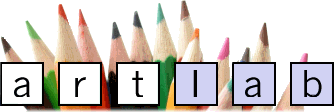|
See davidgauntlett.com for new stuff. |
 |
![]()
QUESTIONS AND
ANSWERS
ABOUT THE ARTLAB APPROACH
What is the approach at the heart of the ArtLab projects?
We conduct research in which individuals are asked to produce media or visual material themselves, as a way of exploring their relationship with popular media or particular issues. This approach is explained in the general introduction (and the questions and answers below follow on from that, so you may want to read that first. And/or: a more detailed introduction appears in David Gauntlett's inaugural lecture).
What would these kind of research methods show, that is not revealed by more conventional research such as focus groups or interviews?
The creative tasks involved in these research studies lead to more reflexive and considered responses, presented initially on the visual plane, and then explored afterwards through language. Conventional qualitative research typically demands instant spoken responses, which can certainly be of value -the quick 'gut reaction' to a question is often interesting. However, the new creative methods elicit a different kind of response, which can lead to different and arguably deeper understandings.
Another important aspect of the approach is that it does not treat individuals as members of specific audience segments (such as 'EastEnders viewers' or 'Cosmopolitan readers'); instead, it is appreciated that the typical consumer of any bit of media is also the consumer of a massive range of other bits of media every day.
Can you give an example?
For example, in the 'celebrities and aspirations' study, school students aged 14-15 were asked to draw a star or celebrity whom they would like to be (if not allowed to continue being themselves). Given a certain range of easy-to-use materials, and time to consider their choice, and how to draw them and the setting they are visualised in, the participants produced a varied and interesting range of artistic responses. Rather than the researcher then having to interpret (or guess at) the 'meaning' of each picture, the participants were then asked to talk and write about what they had done. This leads to a sequence of reflection, response, and further reflection, combining thinking and creative activity.
And what does this process show?
The 'celebrities and aspirations' study was able to identify a range of ways in which young people today think about celebrities, and how this connects with their own aspirations. The stars chosen by young women were most often seen to represent ideals of (in decreasing order of importance) physical beauty, wealth, talent, popularity and confidence. Those chosen by young males represented ideals of (in decreasing order of importance) talent, humour, 'cool', and style. More in-depth analysis of the drawings, and the settings and activities in which the stars were visualised - in association with the childrens' own comments on their creations - was able to explore the significance of various dimensions such as money, fame and friendship.
Another example is the 'Video Critical' project, in which several groups of inner-city schoolchildren aged 7-11 were given video equipment and training, in order to make video programmes about their environment. The project provided a forum in which children themselves gained the opportunity to refute the picture of children painted by much psychological research on children and the media (in which children are seen as inadequate and passive in the face of all-powerful screen media). Instead, the children were able to demonstrate an impressive level of media literacy through the construction of their films, which were assembled to create a narrative argument, and showed a wry awareness of existing media forms. The research also revealed the children's mixed understanding of environmental issues, and the role the media had played in shaping them. In line with children's television programmes (which were also analysed in the study), the videos highlighted local rather than global problems, with an emphasis on recycling and cutting pollution. The participants were well able to produce slogans of the 'save the planet - it's up to you' variety. However, even at the level of their own individual actions, the children's videos and the production process revealed conflicts between the idealistic desire to be environmentally friendly, and the more pragmatic or hedonistic pull of enjoying themselves and not bothering.
What is the significance of asking participants to make something, instead of just, maybe, asking them to think longer and harder about a research question?
The examples above show that the process of reflection at the start of a task, followed by the physical process of creation (during which further ideas and developments usually emerge), followed by reflection and discussion of what has been made, offers a more complex and multi-layered way of considering a topic. This method offers researchers a different and perhaps more reflective way into exploring particular issues.
It is also likely that the creative task stimulates different ways of thinking about a topic, both in terms of which parts of the brain are used, and more obviously in the sense that creating visual works brings the participant to spend longer thinking about the appearances of things. Recent writings on the human brain make it clear than tasks requiring language production call into play areas and forms of brain activity which are different to those used in visual tasks and creativity. A full understanding of the latest work in neuroscience is not necessary to appreciate the central point that by activating ways of thinking which are different to the conventional 'rational discussion' approaches, the creative/visual methods may lead to different kinds of findings.
![]()
ArtLab is run by David Gauntlett at University of Westminster, UK. See the ArtLab features for more introductions and discussions, or ArtLab projects for illustrations of this approach.
![]()
